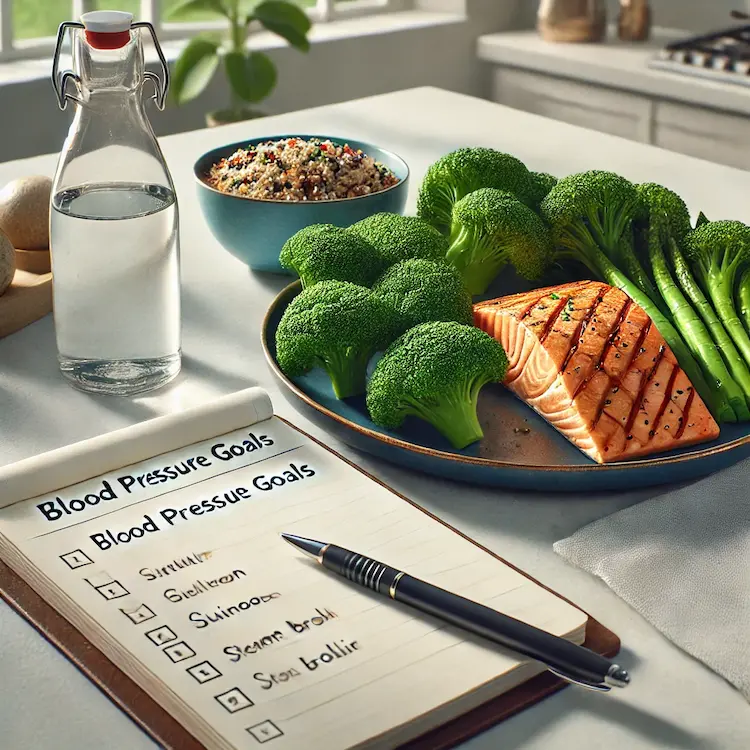Blood pressure is a critical marker of overall health. High blood pressure (hypertension) is a major risk factor for cardiovascular diseases, stroke, and kidney disorders. The World Health Organization (WHO) estimates that over 1.28 billion adults globally suffer from hypertension, with many cases remaining undiagnosed or unmanaged. This article explores how diet and exercise can significantly impact blood pressure, providing practical advice backed by scientific evidence.
Understanding Blood Pressure
Blood pressure measures the force of blood pushing against artery walls. It is recorded as two numbers:
- Systolic Pressure: The pressure when the heart beats.
- Diastolic Pressure: The pressure when the heart rests between beats.
| Blood Pressure Category | Systolic (mmHg) | Diastolic (mmHg) |
|---|---|---|
| Normal | <120 | <80 |
| Elevated | 120–129 | <80 |
| Hypertension Stage 1 | 130–139 | 80–89 |
| Hypertension Stage 2 | ≥140 | ≥90 |
The Role of Diet in Blood Pressure Management
- Adopting the DASH Diet
The Dietary Approaches to Stop Hypertension (DASH) diet is scientifically proven to reduce blood pressure. It emphasizes: -
- Fruits and Vegetables: High in potassium, which counteracts sodium.
- Low-Fat Dairy: Reduces saturated fat intake.
- Whole Grains: Rich in fiber for heart health.
- Lean Proteins: Poultry, fish, and nuts.
- Reducing Sodium Intake
- The American Heart Association (AHA) recommends consuming no more than 1,500 mg of sodium daily. Excess sodium causes fluid retention, increasing blood pressure.
- Incorporating Potassium-Rich Foods
- Foods like bananas, spinach, and sweet potatoes help balance sodium levels.
- Limiting Alcohol and Caffeine
- Excessive alcohol and caffeine consumption can spike blood pressure temporarily and contribute to long-term risks.
Quick Tips for a Hypertension-Friendly Diet:
- Opt for fresh over processed foods.
- Use herbs and spices instead of salt for seasoning.
- Monitor portion sizes to maintain a healthy weight.
The Impact of Exercise on Blood Pressure
- Aerobic Exercise
- Activities like walking, cycling, or swimming lower systolic pressure by 5–7 mmHg on average.
- Strength Training
- Builds muscle and improves overall metabolic health, indirectly supporting blood pressure reduction.
- High-Intensity Interval Training (HIIT)
- Alternating bursts of intense activity with rest periods improves cardiovascular fitness and blood pressure.
- Yoga and Stretching
- Yoga reduces stress, a significant contributor to high blood pressure. Breathing exercises improve circulation.
Exercise Guidelines for Hypertension
| Type of Exercise | Duration per Week | Frequency |
|---|---|---|
| Moderate Aerobic Activity | 150 minutes | 5 days/week |
| Strength Training | 2 sessions | Alternate days |
| Flexibility Exercises | 2-3 sessions | Weekly |
The Synergistic Effect of Diet and Exercise
Combining a balanced diet with regular physical activity has a compounding effect on blood pressure management. For instance, pairing the DASH diet with moderate aerobic exercise can reduce systolic blood pressure by up to 11 mmHg.

Societal and Health Impacts
Uncontrolled hypertension costs healthcare systems billions annually due to associated conditions like heart attacks, strokes, and kidney failure. Encouraging diet and exercise as preventative measures can reduce the societal burden.
Practical Steps for Managing Blood Pressure
- Monitor Regularly
- Use a home blood pressure monitor to track changes.
- Set Realistic Goals
- Aim for small, sustainable changes in diet and activity.
- Seek Support
- Join community programs or online forums for accountability.
- Educate Yourself
- Understand food labels and exercise techniques.
- Consult Professionals
- Work with a doctor or dietitian to tailor your approach.
Comparison of Approaches
| Method | Advantages | Disadvantages |
|---|---|---|
| DASH Diet | Proven, easy to follow | Requires meal planning |
| Aerobic Exercise | Broad cardiovascular benefits | Time commitment |
| HIIT | Quick, highly effective | May not suit everyone (e.g., beginners) |
| Yoga and Meditation | Stress reduction | May take longer to see measurable results |
Conclusion
Impact of Diet and Exercise on Blood Pressure are cornerstones in managing blood pressure effectively. By adopting the DASH diet, reducing sodium intake, and engaging in regular physical activity, individuals can significantly lower their risk of hypertension-related complications. Begin with small steps—substitute processed snacks for fresh fruits, walk daily, or try yoga. These changes contribute to better heart health and overall well-being.
Key Takeaways:
- Prioritize potassium-rich foods and limit sodium.
- Aim for at least 150 minutes of moderate exercise weekly.
- Monitor your progress and adjust as needed.


